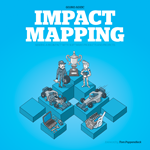Making a Big Impact with Software Products and Projects
by Gojko Adzic
Software is everywhere today, but countless software products and projects die a slow death without ever making any impact. The result is a tremendous amount of time and money wasted due to wrong assumptions, lack of focus, poor communication of objectives, lack of understanding and misalignment with overall goals. There has to be a better way to deliver!
This handbook is a practical guide to impact mapping, a simple yet incredibly effective method for collaborative strategic planning that helps organisations make an impact with software. Impact mapping helps to create better plans and roadmaps that ensure alignment of business and delivery, and are easily adaptable to change. Impact mapping fits nicely into several current trends in software product management and release planning, including goal-oriented requirements engineering, frequent iterative delivery, agile and lean software methods, lean startup product development cycles, and design thinking.
Who is this book for?
The primary audience of this book are senior people involved in building software products or delivering software projects, from both business and delivery sides. This includes business sponsors and those whose responsibilities include product ownership, project oversight or portfolio management, architecture, business analysis, quality improvement and assurance and delivery.
– Business people assigned to software projects will learn how to communicate their ideas better.
– Senior product or project sponsors will learn how to communicate their assumptions more effectively to delivery teams, how to engage delivery teams to make better strategic decisions, and how to manage their project portfolio more effectively.
– Delivery teams that are already working under the umbrella of agile or lean delivery methods, and more recently lean startup ideas, will learn how to better focus deliverables and engage business sponsors and users.
– Delivery teams moving to agile or lean delivery methods will get ideas on how to address some common issues with scaling these practices, such as creating a big picture view, splitting work into small chunks that still have business value and reporting progress more meaningfully.
